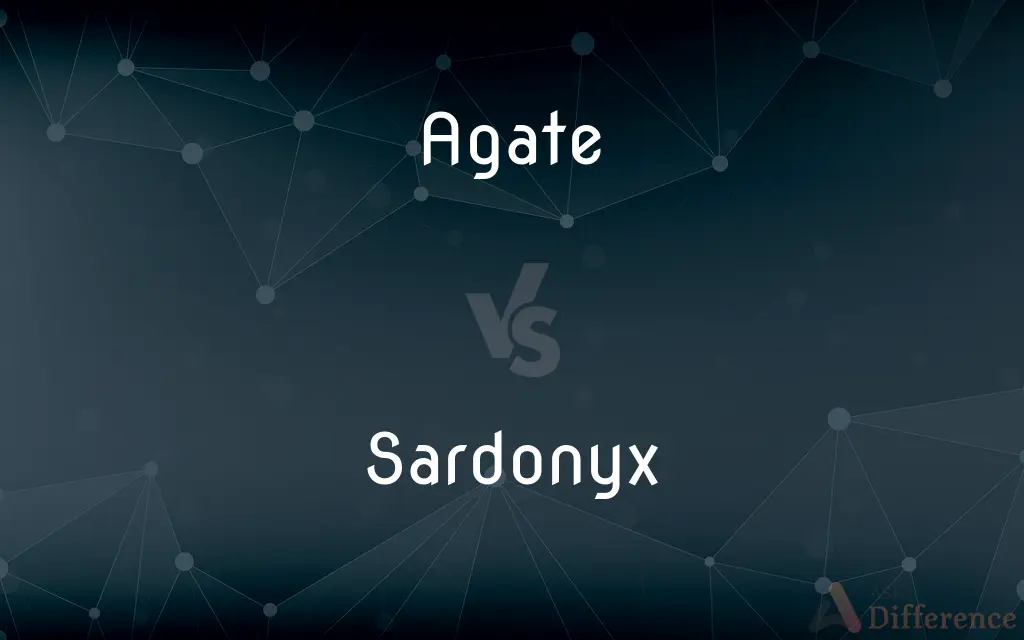Agate vs. Sardonyx — What's the Difference?
By Tayyaba Rehman & Urooj Arif — Updated on March 8, 2024
Agate is a banded, colorful variety of chalcedony, known for its unique patterns, while sardonyx is a specific type of agate that layers carnelian and white chalcedony, famed for its strength and protection qualities.

Difference Between Agate and Sardonyx
Table of Contents
ADVERTISEMENT
Key Differences
Agate is a semi-precious stone, part of the chalcedony family, characterized by its fine bands and wide range of colors. These bands form unique patterns, making each agate piece distinct. Sardonyx, on the other hand, combines alternating layers of sard (a variety of chalcedony with a reddish-brown color) and onyx (a form of chalcedony with parallel bands), resulting in a striking layered appearance. While sardonyx is a specific type of agate, it is distinguished by its particular color combination and layering.
The appeal of agate lies in its diversity and aesthetic beauty. It is found in various colors and is often used in jewelry and decorative items. Sardonyx, with its distinct layering of red and white, has been valued since ancient times not just for its appearance but also for its supposed metaphysical properties, including providing strength and protection. This symbolic significance adds to its value and desirability.
Agate is typically associated with balance and harmony, believed to bring calming influences and emotional healing. Sardonyx, while sharing these qualities, is specifically thought to embody strength, stability, and courage. Its use in amulets and as a stone of protection highlights these attributes, suggesting a deeper spiritual or psychological impact.
The formation process of agate involves volcanic rock deposits filling cavities in host rocks, creating its banded patterns through successive layers of silica. Sardonyx forms in a similar manner, but its specific pattern of sard and onyx layers requires a unique set of geological conditions, making its occurrence more rare and specialized within the agate family.
In terms of applications, both agate and sardonyx are popular in jewelry, carved trinkets, and as decorative objects. However, sardonyx, due to its historical significance and distinct appearance, is often used in pieces that highlight its protective qualities or in works that require a specific aesthetic, such as cameos.
ADVERTISEMENT
Comparison Chart
Composition
Chalcedony with various color bands
Layers of sard and onyx (types of agate)
Color Variants
Wide range, multicolored
Predominantly reddish-brown and white
Symbolism
Harmony, balance, emotional healing
Strength, protection, courage
Formation
Fills cavities in volcanic rocks
Specific layering conditions in host rock
Uses
Jewelry, decorative items
Jewelry, amulets, cameos
Pattern
Unique, varied banding
Distinct, regular red and white layers
Rarity
Common, with many variations
Less common due to specific formation
Metaphysical Properties
Calming, healing
Protective, promotes stability
Compare with Definitions
Agate
A variety of chalcedony with colorful bands.
The agate necklace showcased a stunning array of natural colors.
Sardonyx
A type of agate characterized by red and white layers.
The sardonyx ring featured distinct layers of color, symbolizing protection.
Agate
Found globally, with each region producing distinctive types.
Brazilian agate is renowned for its vibrant colors.
Sardonyx
Often used in cameos and intaglios for its layered effect.
The sardonyx cameo depicted a finely carved historical figure.
Agate
Forms in volcanic rocks through silica deposition.
Agate geodes reveal their beautiful banding when cut open.
Sardonyx
Valued for its strength and historical significance.
Ancient warriors wore sardonyx amulets for courage in battle.
Agate
Known for unique patterns and healing properties.
Collectors prize agate for its beauty and supposed calming effects.
Sardonyx
Believed to promote stability and confidence.
Wearing sardonyx jewelry is thought to bolster self-assurance.
Agate
Used in a wide range of decorative applications.
Agate slices serve as eye-catching coasters and decor pieces.
Sardonyx
Requires specific geological conditions for its formation.
Sardonyx forms where conditions allow for the alternating deposition of sard and onyx.
Agate
Agate () is a common rock formation, consisting of chalcedony and quartz as its primary components, consisting of a wide variety of colors. Agates are primarily formed within volcanic and metamorphic rocks.
Sardonyx
An onyx with alternating brown and white bands of sard and other minerals.
Agate
A fine-grained, fibrous variety of chalcedony with colored bands or irregular clouding.
Sardonyx
A gemstone having bands of red sard; a variety of onyx or chalcedony.
Agate
A playing marble made of agate or a glass imitation of it; an aggie.
Sardonyx
(tincture) A tincture of sanguine colour when the blazoning is done by precious stones.
Agate
A tool with agate parts, such as a burnisher tipped with agate.
Sardonyx
A variety of onyx consisting of sard and white chalcedony in alternate layers.
Agate
(Printing) A type size, about 5 1/2 points.
Sardonyx
An onyx characterized by parallel layers of sard and a different colored mineral
Agate
A semitransparent, uncrystallized silicate mineral and semiprecious stone, presenting various tints in the same specimen, with colors delicately arranged and often curved in parallel alternating dark and light stripes or bands, or blended in clouds; various authorities call it a variety of chalcedony, a variety of quartz, or a combination of the two.
Agate
The size of type between pearl and nonpareil, standardized as 2-point.
Agate
One fourteenth of an inch.
Agate
A diminutive person; so called in allusion to the small figures cut in agate for rings and seals.
Agate
(countable) A tool used by gold-wire drawers, bookbinders, etc.;—so called from the agate fixed in it for burnishing.
Agate
(countable) A marble made from agate.
Agate
A testicle.
Agate
(obsolete) On the way; agoing.
Agate
On the way; agoing; as, to be agate; to set the bells agate.
Agate
A semipellucid, uncrystallized variety of quartz, presenting various tints in the same specimen. Its colors are delicately arranged in stripes or bands, or blended in clouds.
Agate
A kind of type, larger than pearl and smaller than nonpareil; in England called ruby.
Agate
A diminutive person; so called in allusion to the small figures cut in agate for rings and seals.
Agate
A tool used by gold-wire drawers, bookbinders, etc.; - so called from the agate fixed in it for burnishing.
Agate
An impure form of quartz consisting of banded chalcedony; used as a gemstone and for making mortars and pestles
Common Curiosities
How do agate and sardonyx differ?
While agate is known for its colorful banding and variety, sardonyx specifically combines red and white layers, offering unique aesthetic and symbolic significance.
What is agate?
Agate is a semi-precious gemstone, known for its fine banded patterns and wide color range, used in various decorative and jewelry applications.
Can agate and sardonyx be found together?
Sardonyx is a variety of agate, so it shares the same basic formation process but under conditions that create its specific layered appearance.
Why is sardonyx considered protective?
Historically, sardonyx has been associated with strength, protection, and courage, making it popular for use in amulets and other protective items.
What is sardonyx?
Sardonyx is a type of agate that features distinct layers of sard and onyx, valued for its appearance, strength, and metaphysical properties.
What are the uses of agate and sardonyx?
Both are used in jewelry and decorative arts, but sardonyx is particularly favored for cameos and items that emphasize its protective qualities.
Is sardonyx more valuable than agate?
Sardonyx can be more valuable due to its unique appearance and historical significance, although value can vary based on quality and rarity.
How should agate and sardonyx be cared for?
Both should be cleaned gently with soapy water and protected from harsh chemicals and extreme temperatures to preserve their beauty.
How are agate and sardonyx formed?
Both form through the deposition of silica in volcanic rock cavities, but sardonyx requires specific conditions for its red and white banding.
Are there metaphysical differences between agate and sardonyx?
Yes, agate is generally associated with emotional healing and balance, while sardonyx emphasizes strength, protection, and stability.
Share Your Discovery

Previous Comparison
Colourimetry vs. Colorimetry
Next Comparison
Custom vs. CultureAuthor Spotlight
Written by
Tayyaba RehmanTayyaba Rehman is a distinguished writer, currently serving as a primary contributor to askdifference.com. As a researcher in semantics and etymology, Tayyaba's passion for the complexity of languages and their distinctions has found a perfect home on the platform. Tayyaba delves into the intricacies of language, distinguishing between commonly confused words and phrases, thereby providing clarity for readers worldwide.
Co-written by
Urooj ArifUrooj is a skilled content writer at Ask Difference, known for her exceptional ability to simplify complex topics into engaging and informative content. With a passion for research and a flair for clear, concise writing, she consistently delivers articles that resonate with our diverse audience.














































